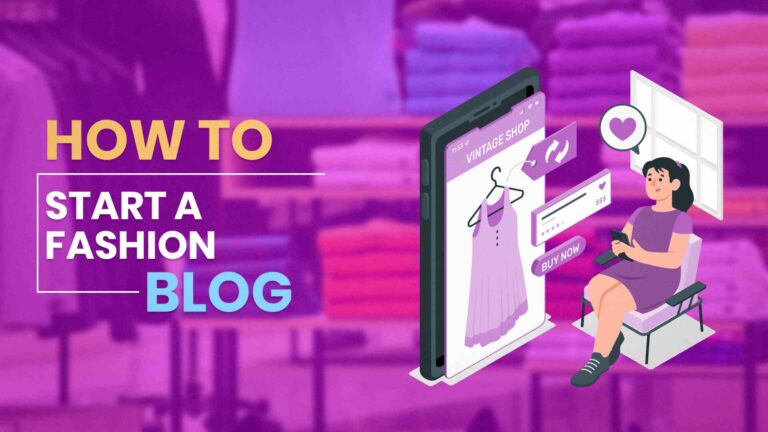Starting a fashion blog in 2025 requires careful planning and execution. Fashion bloggers create engaging content and connect with their audience. They share insights, trends, and tips in the fashion industry. To start a fashion blog, follow these steps.
Steps to Launch Your Fashion Blog
1. Identify Your Niche
To create a successful fashion blog, you must identify your niche. A niche defines your blog’s focus and helps differentiate you from other fashion bloggers. Popular niches include sustainable fashion, luxury fashion, street style, and fashion for specific demographics. For example, sustainable fashion focuses on eco-friendly brands and practices. Identifying your niche helps you attract a targeted audience.
Research Trends
To identify your niche, research current fashion trends. Use platforms like Pinterest, Instagram, and Google Trends to see what is popular. Follow fashion influencers and industry leaders. Analyze their content and observe the styles, colors, and themes they use. Research also helps you discover gaps in the market. Knowing the trends allows you to position your blog effectively and provide content that resonates with your audience.
Define Your Target Audience
To grow your blog, define your target audience. Consider demographics like age, gender, income, and interests. For example, if you focus on luxury fashion, your audience may include affluent individuals aged 25-40. Understanding your audience helps tailor your content. It ensures that your posts resonate with their interests. Knowing your audience’s preferences allows you to create personalized and relevant content that drives engagement.
2. Choose a Blogging Platform
To start a fashion blog, choose a suitable blogging platform. Popular options include WordPress, Blogger, and Squarespace. WordPress is known for its flexibility and customization options. Squarespace is recognized for its user-friendly design tools. Choose a platform that aligns with your technical skills and design preferences.
WordPress
WordPress powers over 40% of websites globally. It offers thousands of themes and plugins, enabling customization of your blog’s appearance and functionality. WordPress is suitable for bloggers looking for scalability. You can upgrade as your blog grows, integrating e-commerce and other features seamlessly.
Blogger
Blogger is a straightforward platform. It is easy to set up and use. However, it offers fewer customization options compared to WordPress. It is ideal for beginners who want to start quickly and focus on content rather than technical details.
Squarespace
Squarespace offers beautiful templates and provides an all-in-one solution, including hosting. Squarespace is suitable for bloggers focused on aesthetics. It allows easy integration with e-commerce features, enabling you to sell products directly through your blog. This platform is perfect for visually-driven content, helping to showcase your fashion style effectively.
3. Select a Domain Name
To establish your fashion blog, select a domain name. A domain name represents your blog on the internet. Choose a name that reflects your niche and brand. Keep it short, memorable, and easy to spell. Ensure that your domain name is available. Use domain registration services like GoDaddy or Namecheap to check availability.
Branding
Branding is crucial for your blog’s identity. Choose a domain name that aligns with your blog’s theme. For example, if your blog focuses on sustainable fashion, consider a name that reflects eco-consciousness. Strong branding enhances your blog’s recognition and helps build a loyal audience. Consistent branding across your blog, social media, and promotional materials reinforces your identity.
4. Design Your Blog
To design your fashion blog, choose an appealing theme. The theme defines your blog’s visual layout. Select a theme that matches your niche and resonates with your target audience. Use high-quality images and a clean layout. Ensure your blog is mobile-friendly, as many users access blogs on their smartphones. A responsive design improves user experience and encourages visitors to explore your content.
Customization
Customize your theme to reflect your style. Use colors, fonts, and images that align with your brand. Incorporate your logo for brand recognition. Ensure easy navigation for users. Categories and tags help users find relevant content quickly. An organized layout enhances usability, keeping readers engaged and reducing bounce rates.
5. Create Engaging Content
To succeed as a fashion blogger, create engaging content. Quality content attracts readers. Consider various content types, including articles, lookbooks, reviews, and tutorials. Use high-resolution images to showcase your outfits. Write compelling captions that provide context. Consistency in posting helps maintain audience engagement.
Blogging Schedule
Establish a blogging schedule. Consistency is vital for audience retention. Create a content calendar to plan your posts. Determine how often you will post, whether weekly or bi-weekly. A schedule helps you stay organized and meet audience expectations. Regular updates keep your content fresh and encourage repeat visits.
SEO Optimization
Search engine optimization (SEO) enhances your blog’s visibility. Optimize your content for relevant keywords. Use headings, meta descriptions, and alt text for images. SEO tools like Yoast SEO for WordPress help you improve your blog’s search engine ranking. Higher visibility leads to increased traffic and potential growth in your audience base.
6. Leverage Social Media
To grow your fashion blog, leverage social media platforms. Social media increases your blog’s reach and engagement. Popular platforms include Instagram, Pinterest, and TikTok. Use Instagram for visual content and engagement. Share outfit posts, stories, and behind-the-scenes content. Engage with your audience through comments and direct messages to build a community.
Pinterest is effective for driving traffic to your blog. Create visually appealing pins that link to your blog posts. Use keywords in your pin descriptions for better visibility. Join group boards to expand your reach. Consistent pinning and engagement can significantly boost your blog’s exposure.
TikTok
TikTok is a rapidly growing platform for fashion content. Create short, engaging videos showcasing outfits, styling tips, and trends. Use popular sounds and hashtags to increase your visibility. TikTok’s algorithm promotes fresh content, offering a unique opportunity for fashion bloggers to gain quick exposure.
Build an Email List
To connect with your audience, build an email list. Email marketing is a powerful tool for bloggers. Use email services like Mailchimp or ConvertKit to create newsletters. Offer incentives for subscribers, such as exclusive content or discounts. Regularly send newsletters with blog updates, styling tips, and promotions to keep your audience engaged.
Engagement
Engage with your email subscribers. Encourage feedback and respond to inquiries. Personalized communication fosters a sense of community. It helps you build loyal readers who are more likely to support your blog and share your content.
7. Network with Other Bloggers
Networking with other fashion bloggers is essential for growth. Collaborate on projects, guest posts, or social media campaigns. Networking enhances your visibility and provides opportunities for partnerships. Attend fashion events, conferences, and online webinars to meet other bloggers and industry professionals.
Collaboration Ideas
Consider collaborative projects like joint Instagram Lives or giveaways. Guest posts on each other’s blogs introduce your audience to new content. These collaborations benefit both parties and can lead to increased traffic and new followers. Building a supportive network helps strengthen your position in the fashion blogging community.
8. Monetize Your Blog
To turn your blog into a revenue-generating platform, explore monetization options. Popular monetization strategies include affiliate marketing, sponsored content, and selling products. Affiliate marketing involves promoting products and earning commissions on sales. Join affiliate programs like Amazon Associates or RewardStyle. These programs provide access to a wide range of fashion products.
Sponsored Content
Sponsored content involves partnering with brands to create content. Brands pay you to promote their products. Ensure that sponsored content aligns with your blog’s theme. Maintain transparency by disclosing sponsored posts to your audience. Authenticity is crucial for maintaining trust and credibility with your readers.
Selling Products
Consider selling your products or services. You can create an online shop on your blog. Sell merchandise like clothing, accessories, or digital products. E-commerce platforms like Shopify or WooCommerce simplify the selling process. By offering unique products, you enhance your brand’s identity and create additional revenue streams.
9. Stay Updated with Trends
To maintain relevance, stay updated with fashion trends. Follow fashion news, attend fashion shows, and engage with industry experts. Subscribe to fashion magazines and blogs. Use platforms like Vogue, Harper’s Bazaar, and Business of Fashion for insights. Continuous learning helps you remain informed and inspires your content creation.
Trend Forecasting
Trend forecasting is essential for fashion bloggers. Analyze upcoming trends and adapt your content accordingly. Utilize tools like WGSN for trend analysis and reports. Incorporate trending topics into your blog posts to attract attention. Timely content can significantly increase engagement and visibility.
10. Analyze and Adjust
To improve your blog’s performance, regularly analyze your metrics. Use tools like Google Analytics to track traffic, engagement, and demographics. Understand which content performs well and resonates with your audience. Adjust your strategy based on data insights. Continuous improvement enhances your blog’s growth and success.
Metrics to Monitor
Monitor key metrics such as page views, bounce rate, and time spent on the site. Analyze social media engagement metrics to gauge audience interaction. Use this data to refine your content strategy and optimize your posts for better performance.
Conclusion
Starting a fashion blog in 2025 requires careful planning and execution. Identifying your niche, choosing the right platform, and creating engaging content are crucial steps. Leveraging social media and networking with other bloggers enhances your reach. Exploring monetization options allows you to turn your passion into a revenue-generating platform. Staying updated with trends and analyzing your blog’s performance ensures continuous growth. By following these strategies, you can create a successful fashion blog that resonates with your audience.
Read Also:
How To Start A Hair Blog In 2025
How To Start A Lifestyle Blog In 2025
How To Start A Skincare Blog in 2025
Frequently Asked Questions (FAQs)
What is the best platform for starting a fashion blog?
WordPress is widely regarded as the best platform due to its flexibility and extensive customization options.
How often should I post on my fashion blog?
Consistency is key. Aim for at least one post per week to keep your audience engaged.
How can I monetize my fashion blog?
Monetization options include affiliate marketing, sponsored content, and selling your products or services.
What social media platforms are best for fashion bloggers?
Instagram and Pinterest are highly effective for fashion content, while TikTok is rapidly growing in popularity.
How can I stay updated with fashion trends?
Follow fashion magazines, blogs, and industry experts. Attend fashion shows and subscribe to trend forecasting services for insights.

